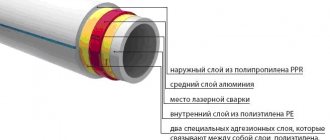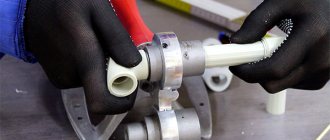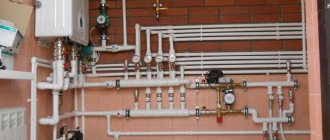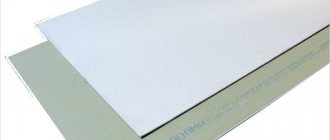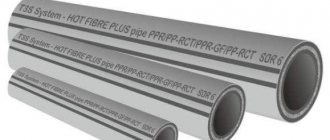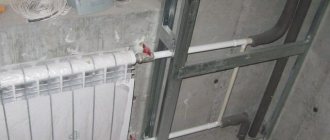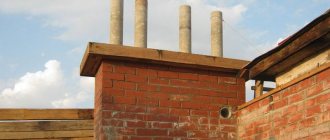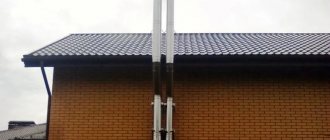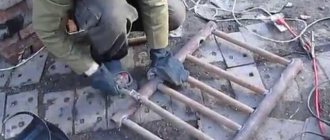Laying heating pipes in the wall
In previous articles we talked about what kind of pipes can be used for a home heating system, and today we’ll talk about attaching heating pipes to the wall.
Attention, here is useful information and answers to the questions of whether heating pipes can be hidden in a concrete wall and what devices are available for attaching heating pipes to the wall.
How to hide heating in a concrete wall
To hide heating pipes in the wall, you can go in two ways:
- cut grooves in a concrete wall;
- erect a new false wall.
Let's consider a method for laying heating pipes in the wall of a multi-story building. Naturally, this is possible if a new circuit is assembled, or structural changes are made to the old one. Since initially the wall and the heating system are in different planes. In order for them to be located in the same plane on the wall surface, you need to cut out channels and place communications in them. What you need to pay attention to:
- Before removing the heating pipes, the riser is closed in the wall to cut off the old heating. There is no need to make hasty decisions. Make sure to turn off the required riser, as using an electric angle grinder can result in an electric shock. This is the case if water begins to flow like a fountain from the cut;
- wall thickness - if you decide to hide communications in thin walls and the depth of the groove will be more than half the thickness of the partition, it is better to abandon this idea. For example, in the bathroom. In a panel house, the bathroom is a separate concrete block. The thickness of its walls is not enough;
- groove sizes. They should not be end to end and in no case should they restrict the contour, resting against the ends or walls. It must be cut taking into account the mounting for the heating pipes, its diameter and insulation;
- isolation of communications. Before walling up heating pipes in a wall in a panel house, they must be insulated from concrete, since condensation may form on their surface;
- fastening communications in the groove. Before attaching heating pipes to the wall, identify key locations. These are connections and segments that change the vector of coolant motion.
To make it easier to tap walls, you need to use a grinder and a hammer drill. First you need to mark where the heating will be hidden, and then use a grinder to cut along the marking lines to the required depth. Then use a hammer drill to knock out the concrete between the slots. Please note that when working with an angle grinder there is a lot of dust and noise too. There are modern professional tools for cutting grooves that are connected to a construction vacuum cleaner. There is no dust at all when working with such a tool in the room.
When bricking communications into a wall, they must be securely secured in channels cut into the concrete (grooves). The fastening of heating pipes to the wall is selected to a certain diameter.
According to the rules, all docking points must be freely accessible. Naturally, these include equipment installation sites: meters, filters, pumps, taps, etc. That is, only those areas in the wall remain where leakage is minimized.
Characteristics of polypropylene pipe products
Today, such pipes are used, among other things, for laying household pipelines. In addition to completely plastic products, pipe products reinforced with fiberglass or aluminum are popular. It is more durable and less sensitive to temperature changes.
Unreinforced pipes are used exclusively for systems through which cold water moves. To lay a plastic water supply or heating structure, products with a diameter of 20 to 110 millimeters are used. Products with non-standard cross-sectional dimensions are produced exclusively on special orders.
The main characteristic of polypropylene pipes is the wall thickness. Often a table is attached to the products, which reflects the requirements for materials for heating and water supply systems with different ambient temperatures and different loads.
How to hide communications behind a false wall
Heating hidden behind a false wall
Everything is quite simple here. You need to build a structure from metal guides and sew it up with any material you like:
- drywall;
- blockhouse;
- lining and others.
There is a myth that this reduces the usable area of the apartment. Fortunately, this remains a myth. If you need to hide pipes, these are usually places under or next to a window. All the space that is above a meter in these areas is absolutely not used in real life. The maximum that can be lost is 15 cm under the windowsill. At the same time, the window sill itself will accordingly become 15 cm wider. Agree that adding to the width of the window sill is much better than the same unused space under it. You can also insulate the walls from the inside.
There is an option to leave everything as it was originally, that is, the communications are attached to the wall and there is no need to hide anything. But, if we are talking about high-quality modern repairs, this option is unacceptable.
Video
In this video, a specialist will share his knowledge and tell you how to install a home heating system with your own hands:
Today, water supply is produced using modern materials.
Metal-plastic pipelines have become a very popular option for using these products for cold and hot water supply, as well as heating. However, it is worth knowing that when installing metal-plastic pipes with your own hands, it will be appropriate to additionally install gearboxes. This type of pipe does not like pressure drops in the system; reducers equalize this pressure.
Water pipe routing diagram.
To isolate or not
If we consider the insulating material only as insulation for heating pipes in the wall, then it need not be used. Let's decide why we need to insulate walled-up communications. Obviously, so that the heat does not go to God knows where. And in the case of walls, it can only evaporate through surfaces in contact with the street. If communications are hidden in the internal wall, then the problem of heat loss is not a problem at all. All the heat that the coolant will give to the concrete, and it, in turn, will give off heat to the air in the room.
At the same time, insulation of communications is carried out not only for thermal insulation. It is important to create a barrier to liquid - waterproofing. After all, the temperature in the heating is quite high and condensation can form when interacting with the wall. Where there is moisture, there is fungus, which is absolutely unacceptable. Another very important function of insulation is protection against mechanical stress. For example, when a groove is sealed. But the most important thing is the thermal and linear expansion of the pipes when heated. That is, when heated, they change their geometry, becoming larger in diameter and longer.
Options for insulating heating pipes in the wall, pros and cons:
- polyurethane foam.
In principle, any one will do, but better, of course, is a professional one with a low expansion coefficient. Such foam is more expensive, but it will secure the communications in the groove and will not change their location. While ordinary foam, if the heating is not sufficiently fixed, can disrupt the geometry of the system;
- foamed polyurethane or expanded polystyrene.
Foamed polystyrene insulation
This material is resistant to high temperatures and does not allow water to pass through. In addition, it creates the necessary buffer zone for thermal expansion. Such materials include Energoflex. It is produced in rolls or in blanks in the form of pipes. In the latter case, the internal diameter coincides with the standard pipe sizes and there is a slot along the product. The outer part can be made of foil for greater thermal insulation. The insulation must be put on in such a way that the slot faces upward and before the heating pipes are attached. If condensation occurs, it will not leak out or be absorbed into the wall;
- corrugated pipe
A product made of plastic or metal that only protects against damage and provides space for thermal and linear expansion, which is accompanied by pressure changes.
Before bricking the heating into the walls, it is necessary to insulate it. It's not about thermal insulation or even protection from mechanical damage. The main task is to give the system space for thermal and linear expansion.
When the insulation and strengthening are completed, all that remains is to check the circuit for tightness and resistance to loads. To do this, pressure testing of the heating system is carried out. These are hydraulic or manometric tests that are carried out in accordance with regulatory documents and SNiPs. After this, you can think about how to seal the heating pipe in the wall. Plaster or cement will do.
Laying pipes through ceilings
Pipelines are made of steel, polymer compounds, and copper. Floors can be made of hard materials (brickwork, reinforced concrete) or soft materials (plaster, wood, dry plaster compositions). Laying pipes in a bathroom, for example, may require immersion into the thickness of partitions and floors/walls up to 10% of the wire area. Therefore, builders and installers have natural questions:
- How will long-term contact with hard building materials of walls and ceilings affect the performance of communications made of soft materials?
- Will the hard alloy line damage the soft floors?
Regulatory documents make vague and ambiguous requirements. Therefore, only a qualified craftsman should lay such a structure; “handicrafts” are inappropriate here. An incorrectly laid pipeline unit is a potential danger of emergencies and accidents, leading to losses
Therefore, it is important to know the correct answer to these questions
SNiP standards
- An uninsulated pipe passage through a wall should not come into direct contact with building structures.
- In the absence of insulation, the distance from the main to the plaster or facing coating should be 35-55 mm (with a passage diameter of 32 mm), 50-60 mm (with a diameter of 40-50). When using parts with a larger cross-section, the gap is determined according to the working documentation.
- The area where risers pass through building floors is treated with cement mortar throughout the entire thickness of the latter.
- Fragments of risers protruding 8-10 cm above the ceiling are protected with a 2-3 cm layer of cement.
- Before applying a protective composition to the sewer riser, the pipes must be wrapped with rolled waterproofing in a continuous layer without gaps.
Important: the requirements of regulatory documents for the technology of crossing pipeline nodes of various building elements may differ or contradict each other. If you are in doubt about the correctness of the created project, seek advice from a professional plumber or builder
Only knowing the features of the working materials and the planned design can you create an accident-free project.
What does the technology of work depend on:
- Material of building elements (load-bearing walls, partitions in living rooms, bathrooms, foundations and ceilings).
- Places, number of entrances and type of crossing of “obstacles” by the highway.
- Type of installation (open/closed).
- Highway type.
- Pipe shape.
Requirements for laying polypropylene pipes
When manufacturing pipeline assemblies from polypropylene and metal-polymer alloys, the following requirements are imposed on the structure:
It is mandatory to install sleeves (cases) to ensure mobility and unhindered movement of the connection inside the building element. The diameter of the sleeve is taken with the calculation of +5-10 mm to the working outer diameter, its length should rise by 20-50 mm above the overlap level. In the case of hidden installation, it is necessary to provide for the possibility of thermal expansion of pipes. The ends of the cases and the gaps between the sleeve and the working surface are sealed with a pliable, non-flammable material so that it remains possible to move the pipe along the longitudinal axis. For sealing, impregnated linen fabric and ropes impregnated with a solution of polyisobutylene in gasoline (at a ratio of 1:3) are used. If tarred rope is used, the plastic pipe is wrapped in polyethylene or polyvinyl chloride film. When sealing the gap with asbestos fabrics or cords, the ends of the sleeve are sealed using germinite
Important: some sources for structures made of metal-polymer alloys prescribe the use of sleeves only made of metal or plastic, others say that the pipe passage through the ceiling can be mounted without protective elements. The joints of the main line are prohibited from being placed in cases.
It is allowed to use roofing felt, roofing felt or glassine as protection. To do this, the structure is wrapped in soft material in two layers and tied with twine. The wall thickness of the sleeve and other technical characteristics are calculated based on specific tasks and the type of material (cross-linked polyethylene, polyvinyl chloride) and type of construction (cold/hot water supply, heating, sewerage, drains, etc.)
It is also important to take into account the type of room in which the joints of square or round pipes are laid, and the technology for preparing the holes (how and where - manually or in the factory)
How to attach it to the wall
Various devices are used to attach communications to the wall. They are rigid and sliding (floating). The fixed support for the heating pipes holds with a death grip, and there is no possibility for the contour to move. In sliding fasteners, the pipe may move slightly during linear expansion. In the circuit, rigid and sliding fasteners should alternate.
Types of fastenings:
- metal clamps.
Clamps
These are fasteners that consist of two half-rings connected by bolts. Tightening is done using a screwdriver. A screw is soldered to one half-ring, which is screwed into a dowel inserted into a prepared hole in the wall. Clamps come with or without a rubber insert on the inner surface of the ring;
- clips.
Designed for fastening plastic heating pipes to the wall. They have a simple design. First, the fasteners are installed, and then the circuit assembly begins. Communications are easily inserted into the mount; fixation is accompanied by a click. This type of fastening cannot be considered the most reliable, since the pipe can jump out of it even with little force. They are not used for products with a cross-section larger than 50 mm;
- plastic tightening clamp.
Unlike metal clamps, these heating pipe fasteners have only one attachment point. Thus, it turns out not two half rings, but one broken one. It is molded in such a way that there is a plastic dowel at the bottom. It is inserted into the drilled hole, and the screw that is screwed into it simultaneously secures the clamp in the wall and tightens the ring around the pipe;
- dowel-hook.
Plastic clips and hooks
It is designed for attaching communications to a flat, straight surface. It looks like a plastic screw with half-arcs at the head. It is twisted or lightly hammered into the prepared hole;
- crab systems.
Used for fastening steel heating pipes to the wall and to each other. Comes in three different forms:
- in the form of the letter “T”;
- in the form of the letter “G”;
- in the form of the letter "X".
It holds communications no worse than welding seams, and has the advantage of being quickly dismantled.
External gasket
It is considered the easiest way to install the necessary pipes. On the other hand, pipeline systems remain visible, which is not always appropriate from the point of view of the attractiveness of the building. Among the advantages of the described method, it makes sense to highlight the following:
- Simplicity. Heating installation is carried out quite quickly and does not require various preparatory measures.
- Availability. If necessary, the pipelines can be repaired without any problems since they are easy to access.
- No heat loss. Since the surface of the pipes does not come into contact with the wall structures or floor, the heat does not disappear anywhere, but is distributed throughout certain rooms.
- Economical. To lay pipes along the external areas of various building elements, small amounts of different materials are required. No adapters, no insulation products, or putty are needed.
Advantages and disadvantages
To be honest, laying heating pipes in a concrete wall is nonsense. The question is why? What is the purpose of this complex, costly and risky procedure?
The advantages of embedding heating into the wall cannot be called objective. But here are the obvious disadvantages:
- complex installation. Before laying heating pipes in the wall, think about the fact that connecting the elements is very inconvenient. Metal communications are extremely difficult to properly solder in a groove;
- risk of leakage. Moreover, in order to eliminate the leak, you will have to break the entire wall, not to mention the fact that it is almost impossible to directly determine the location of the leak if there is no wet spot on the wall;
- the need to perform complex, labor-intensive processes, such as installing heating pipes in the wall.
If you decide to hide communications in concrete walls, it’s better to think a little more, maybe this idea will go away on its own. Another thing is a false wall:
- convenient access to key system components;
- wide window sills;
- saving money and time.
To summarize, let's highlight the main points. Firstly, there is no need to bury communications in concrete walls; it is better to hide them behind a false wall. Secondly, you need to insulate the pipes and thirdly, securely fasten them using special clamps and clips.
Wooden box
Natural wood always looks very advantageous in the interior. Of course, there is little point in using it in the bathroom, since it will not last long there. But for masking pipelines in living rooms, this is an excellent option. Of course, creating a wooden box will take longer than previous options. But you can buy ready-made products designed specifically for masking pipes and radiators. It is worth considering that wood has very low thermal conductivity. If the box is monolithic, then all the heat generated by the pipes will remain in it.
In order not to leave the room to freeze, it is advisable to install a box made in the form of a lattice. Of course, the cleaning procedure for such a structure will be somewhat more complicated, but the level of heat transfer will be quite sufficient, and the appearance will not deteriorate at all.
Another point that must be taken into account when installing a wooden box is the instability of the material to high temperatures. If the heating elements are located too close to the walls, the wood will soon dry out and generally lose its external luster. To prevent this from happening, it is necessary to provide for a distance from the walls of the box to the pipe; it should be about 3–4 centimeters.
Features of decorating pipes in a private house and apartment
There are more options for hiding heating pipes in a private home. Internal communications of private buildings are in no way connected with neighboring ones and, accordingly, if necessary, can be laid and re-routed as they please. If changes to the configuration of the heating system are planned in an apartment building, then the interests of all residents must be taken into account and agreed upon with the operating organization.
Pipes can only be completely hidden during construction or major repairs. For this purpose, hidden gaskets are used in the walls or floor. Pipelines with thermal insulation are placed in grooves and covered with mortar or hidden under moldings. In individual heating systems, floor heating can be arranged. In private houses, it is convenient to hide communications between the logs of wooden flooring. All that remains is to cover the intersections of the pipes with the floor with decorative overlays, as shown in the photo.
The biggest inconvenience for apartment residents is the main transit pipelines, which, due to their large size, are difficult to hide. In addition, if you overdo it with the shelter, you can lose some of the heat entering the room. To disguise them, only external decoration techniques are suitable.
When decorating heating pipes in your home, you don’t have to worry about changes in their heat output. In individual systems, room heating will remain the same, only the ratio of the amount of heat supplied from pipes and radiators will change. But in apartments with centralized heating, you have to save every kilocalorie of thermal energy and leave the pipelines as open as possible.
One way or another, any actions in relation to the elements of the heating system affect its functioning. Before taking drastic measures to move pipelines out of sight, you should study the complete layout of the existing wiring and analyze the possible consequences.
Important! Hidden laying can only be used if new high-quality pipes without threaded connections are used. All dismountable areas and fittings must remain accessible for maintenance
This is especially important in apartments, where the occurrence of an emergency situation is fraught with flooding of neighbors.
In some cases, the best option is to decorate openly laid pipelines and radiators. This allows you to make them invisible at minimal cost, without compromising the integrity of the walls and floor and without changing the configuration of the heating circuit. At the same time, all design parameters of the heating system and free access for ease of operation are preserved. When choosing how best to decorate a heating pipe in a room, you should be guided by both aesthetics and functionality considerations.
Hidden gasket
Hidden installation of heating pipes.
The obvious advantage, compared to the previous method, lies in its aesthetic appeal.
There are practically no restrictions on interior design, since the heating pipes are disguised. Nothing will interfere with the installation of furniture groups or the implementation of any design ideas.
In addition, communications are reliably recorded. As for the disadvantages, they are as follows:
- Labor intensive. For hidden installation of a heating pipeline, a lot of effort has to be made to carry out the work in accordance with established standards. Everything is too complicated and confusing.
- Presence of heat loss. No matter how well the pipes are insulated, some of the heat will still be wasted on warming up the protective structure, which, by the way, simultaneously performs decorative functions.
- High price. More materials are required, which increases the cost.
- Difficult maintenance. Heating communications laid according to a hidden principle are almost impossible to properly repair. Any maintenance costs a lot of money, since in order to gain access to problem areas it is necessary to dismantle decorative and protective structures.
Finish price
Many people who have decided to decorate pipes in their apartments have a question about which method is the most economical. Answering this question, we can immediately talk about painting. If, for example, you choose alkyd enamel as a painting material, then a can will cost you no more than 200 rubles.
Drywall is also an available material for decoration. The cost of sheets of this material starts at 200 rubles. But they alone will not be enough to decorate heating pipes. You will also need profiles, the average price tag for which starts from 50 rubles. You will also need skirting boards, the cost of which starts from 20 rubles.
In order for the plasterboard structure, behind which the pipes are hidden, to look aesthetically pleasing, putty is necessary. Prices for such compositions start from 100 rubles. If you decide to build a false wall, then in this case you will have to spend much more on material. You can't get by with drywall. You will also need to purchase wall panels, prices for which start at 150 rubles. for 1 sq. m. You will also need screens for radiators, which cost 300 rubles in stores.
You can also decorate heating pipes in an apartment by using jute rope. This material is quite inexpensive. The maximum price for it is 120 rubles. for 1 linear meter. You can also use hemp rope, prices for which vary from 10 to 880 rubles. The most expensive method is stained glass. If you choose this option for decorating pipes in your apartment, you will have to pay several thousand rubles for this pleasure.
Kinds
In order to decorate pipes in a room and hide them from those present, you can use several options, these are:
Recessing heating structures directly into the wall, which in itself is very convenient and not so difficult to implement, but in case of any problems the consequences will be very bad
When installing a pipeline, it is important to completely replace it and carefully check all fastening points, soldering points and any joints that may leak. Disguise using furniture, which is most often typical for the kitchen, but can sometimes be found in other rooms. Using a special box where the pipes are placed. You can make such a structure from different materials, these are: plastic lining, brick, plasterboard, wood.
The box for heating pipes can have a varied appearance, which depends on the room in which it is installed.
- A box-cabinet that forms a closed space where you can not only hide pipes, but also place little things you need in everyday life. It is very convenient to use it in the toilet, where space is significantly limited.
- A plinth box is needed to hide pipes with a small diameter; it is very convenient to install sockets near them, especially for the bathroom, where the humidity level is high and you need to choose the right place to turn on electrical appliances.
- A shelf box with a horizontal arrangement. This is convenient for proper installation of heating structures in the room. You can effectively, but at the same time effectively hide all communications, making the area useful.
- A screen box that helps cover large structures. Screens can be very diverse in design and size, but they will have one thing in common: a mesh structure, which allows you to minimize heat loss without depriving the room of its aesthetics.
- Decorative vertical structures are installed in places of common building communications, most often these are risers.
When planning the construction of any of the above options, you need to know that you can build two types of structures that will have radically opposite characteristics:
- Collapsible structures, their installation allows you to easily monitor the condition of the pipeline in any part of the room and control problem areas, if any.
- Stationary structures that are installed for the longest possible service life and are not planned to be disassembled for a long time. Most often, such boxes are made for gas pipes; they would not be the best option for heating.
Any type of structure can be purchased or made independently, which requires an understanding of what exactly will be built and the use of the correct structural elements. If you need to hide the battery, then you cannot do without a screen, and it must be perforated, otherwise it will not be able to cope with the task and the box itself will overheat, while the room will remain cold. The gratings can be either plastic or wooden, but if desired, you can even order forged products.
Any pipes that are in a house or apartment have an entry point and exit point from the room, which obliges them to decorate these areas as well. The best way to deal with this is overlays or plugs. Externally, they can have a varied appearance and even be made of different materials, but they have one task, to hide the pipe and make the interior of the room stylish and beautiful. Most often, it is the rings that are found, but you can also find square and oval options; in addition, they can be designed for one or two pipes.
Modern technologies also require new approaches to the use of materials; for example, when installing suspended ceilings, pipes need to be bypassed, which, in turn, requires making holes in the canvas that need to be closed. Decorative rings are now used for such purposes.
Their design is extremely simple, but still effective, these are two identical halves that have a special lock at the junction that snaps into place and is securely held in place
It is important to choose the right material and color of such plugs so that they fulfill their role
In the event that you cannot hide the entire pipe, but you need to decorate it beautifully, cups are great for this. They can be made in different sizes, shapes and materials. Chrome is most often used, but plastic can also be used, which has a split design.
If the design has valves or other moving elements that need to be used from time to time, then you can hide them under a cap that matches the decor of the room, so as to blend in with it and not be noticeable, but if necessary, make it possible to use everything you need.
